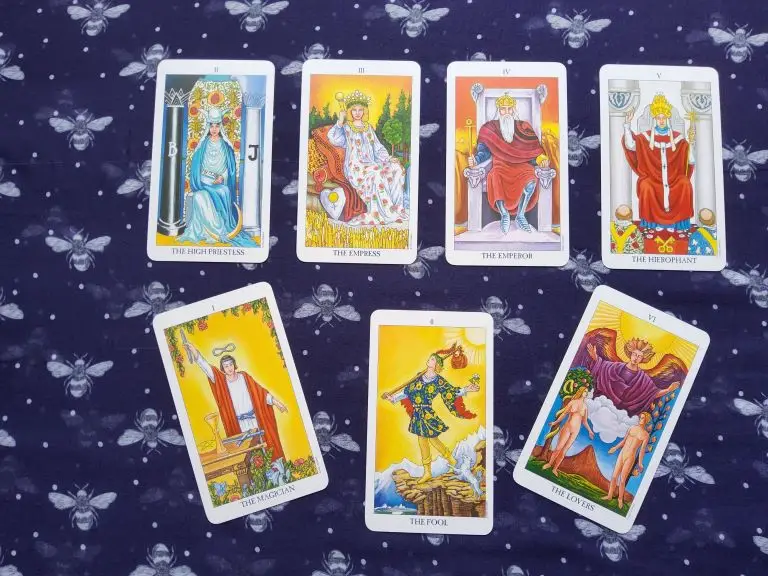Explore the first stage of the Fool’s Journey — The Call to Adventure in Tarot. Discover the deeper meanings of the Magician to the Lovers and how these archetypes reflect your personal growth.
The Call to Adventure in Tarot: From the Magician to the Lovers
The Tarot isn’t just a set of cards for fortune-telling. It’s a mirror of your personal evolution, a guidebook to inner wisdom. One of the most powerful ways to explore this is through the Fool’s Journey, a symbolic path that weaves through the 22 Major Arcana cards. Each card represents a stage of life’s spiritual and emotional development.
The journey begins with the Fool, card 0, representing innocence, openness, and a leap of faith into the unknown. From there, the first real chapter is what we call the “Call to Adventure” – a series of encounters and lessons from card I (The Magician) through card VI (The Lovers).
These six archetypes lay the foundation for the Fool’s growth and mirror our early experiences of identity, relationship, structure, and choice. Let’s take a deeper look into each card and how they relate to your own spiritual path.
Card I: The Magician – Tapping Into Your Power
As soon as the Fool steps forward, he meets the Magician. This figure is dynamic and full of energy, standing before a table with the four suits of the Tarot: wand, cup, sword, and pentacle. These tools symbolise the resources we all have at our disposal—our passions, emotions, intellect, and physical presence.
The Magician says: “You already have everything you need to begin creating your life.”
When I first encountered this card during a personal reading, I had just made a huge career change. I remember feeling completely unsure if I had what it took to make it work. The Magician reminded me that self-belief and intention are the spark that ignites real change.
This card encourages you to step into your power, use your skills, and be intentional with your actions. It marks the beginning of conscious creation.
Card II: The High Priestess – Trusting Your Intuition
Next, the Fool encounters the High Priestess. If the Magician represents outward action, the High Priestess symbolises inward wisdom. She sits between two pillars, guarding the threshold to the subconscious.
This is the moment when the Fool is asked to pause and listen. It’s not just about doing—it’s about being. The High Priestess invites you to trust your gut feelings, your dreams, and the subtle messages from within.
In practical terms, this card often appears when we’re being called to reflect, journal, meditate, or simply sit in silence. It can signal that the answers you’re looking for are not “out there”—they’re already within you.
Card III: The Empress – Embracing Creativity and Nurture
Now the Fool meets the Empress, the embodiment of abundance, nature, and the divine feminine. This card speaks to creativity, sensuality, and fertility—not just in the biological sense, but in all things you want to bring to life.
This might be the part of your journey where you’re creating something new: a project, a family, a home, or even a new way of thinking. The Empress says it’s okay to take pleasure in the process and to nurture your ideas gently and with love.
A friend of mine pulled this card repeatedly while renovating her home. She took it as a nudge to infuse the space with beauty, comfort, and care—and she swears it helped her fall in love with the process, even when it was messy.
The Empress reminds us that creation takes time and love. It’s not about rushing; it’s about connection and patience.
Card IV: The Emperor – Establishing Structure and Stability
While the Empress nurtures, the Emperor builds. He represents authority, rules, and protection. He provides the structure that allows creativity to thrive.
When the Fool meets the Emperor, he learns about boundaries, discipline, and responsibility. This card often shows up when we’re being asked to take control, set goals, or manage our time and resources more effectively.
The Emperor isn’t always the most comfortable card—especially for free spirits—but he’s essential. He reminds us that freedom thrives best within a strong, safe container.
Think about any long-term success in your life. It likely involved some kind of plan, commitment, or routine. That’s the Emperor’s domain.
Card V: The Hierophant – Learning from Tradition
The Fool’s next step is guided by the Hierophant, also known as the High Priest. This card introduces tradition, belief systems, and spiritual authority. It’s about learning from established paths, whether through religion, mentorship, or a school of thought.
Some people resist the Hierophant, especially if they’ve had negative experiences with authority or organised systems. But this card isn’t about blind obedience; it’s about finding wisdom in structure.
Personally, I connected with the Hierophant during a time when I started practising regular meditation and breathwork. I didn’t invent the techniques—I learned them from others. This card reminded me that sometimes we grow most when we seek guidance.
The Hierophant encourages you to consider: who or what are your teachers right now?
Card VI: The Lovers – Making Meaningful Choices
Finally, the Fool arrives at the Lovers. While it’s often interpreted as a card of romance, its deeper meaning is about alignment, connection, and choice.
This is the moment in the journey when the Fool must decide: which path is aligned with my heart and values?
The Lovers ask you to evaluate your relationships, your commitments, and your decisions. Are you choosing out of fear or out of love? Out of duty or desire?
Many people feel this card arise during pivotal life moments: moving cities, changing careers, entering or leaving a relationship. It invites you to choose with awareness and integrity.
One of my clients once said pulling the Lovers helped her realise she’d been saying “yes” to too many things out of obligation. She used it as a prompt to reassess where her energy was truly needed.
The Call to Adventure Is Your Foundation
These six cards – the Magician through the Lovers – form the foundation of the Fool’s evolution. They represent the early stages of your own spiritual path: activating your potential, tuning into your intuition, creating and nurturing, establishing structure, seeking knowledge, and making choices.
Together, they are the Call to Adventure—the initiation into a deeper, more conscious life. They ask you to engage both your inner and outer worlds, to explore who you are and what you value.
Whether you’re reading Tarot for yourself or just exploring these archetypes as metaphors, consider where you are in this part of the journey:
- Are you ready to take action like the Magician?
- Do you need to slow down and reflect with the High Priestess?
- Are you building something new and need the Empress’ nurturing touch?
- Is it time to set boundaries and step into leadership like the Emperor?
- Could a teacher or tradition help guide your next step like the Hierophant?
- Are you standing at a crossroads, needing to choose like the Lovers?
Wherever you are, the Call to Adventure is always available to you. All it takes is the courage to say yes.
Final Thoughts – Adventure in Tarot
The Fool’s Journey is more than a story. It’s a lens through which to see your own growth. The Call to Adventure—from the Magician to the Lovers—is a crucial chapter that sets the tone for the entire path ahead.
These archetypes offer powerful guidance. They remind us to blend action with intuition, creation with structure, learning with discernment, and choices with heart.
So next time you pull one of these cards, take a moment. Ask yourself how this archetype is playing out in your life. The answers may surprise you.
The adventure has already begun. All you have to do is keep walking.
Extra Resources:
- Explore Soul Tarot readings.
- This post may also interest you: What is a spiritual awakening?
- Buy your own Tarot Cards!
Best Wishes,
David.
© D. R. Durham, All rights reserved, 2025.



